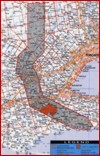|
|
![]()
|
![]()
|
![]()
|
|
|
![]()
|
![]()
|
![]()
|

|
![]()
|
The Haldimand Treaty of 1784
Whereas His Majesty having been pleased to
direct that in consideration of the early attachment
to his cause manifested by the Mohawk Indians
and of the loss of their settlement which they
thereby sustained - that a ...  View More View More
|
![]()
|
|
![]()
|
![]()
|
![]()
|
|
|
|
![]()
|
![]()
|
![]()
|
|
Land Use Unit
|
![]()
|
The uncertainties as to jurisdiction and ownership on lands where Six Nations’ interests remain unattended and addressed by the Crown have resulted in various confrontation and blockades against municipal developments. As an interim measure, the Indian Commission of Ontario mediated the signing of the Grand River Notification Agreement (GRNA) on October 3, 1996. It was the first of its kind in Canada where Municipalities, First Nations, a Conservation Authority, and the Governments of Canada and Ontario agree to information sharing, consultation on economic development, land use planning and environmental issues without prejudicing Six Nations’ Land Claims.
By 2004, the Wildlife Management Office was reviewing over 700 permits/licenses a year through the GRNA. In order to respond to the numerous notices/applications, the Land Use Unit was developed as a branch of the Six Nations Lands and Resources Department. This Unit monitors the development of lands and the use of resources within the Six Nations Territory, and ensures that Six Nations’ treaty rights and interests in our 1701 Treaty territory are asserted and protected.
The Supreme Court of Canada’s key court case Haida Nation, Taku River Tlingit First Nations, Mikisew Cree, Tsilhqot’in and Keewatin decisions confirm the legal obligation to consult and accommodate First Nations; even where the claim has not been proven. A Consultation and Accommodation Policy was created 2009 and a Consultation and Accommodation Process Team (CAP) was created to meet with the several developers/proponents that would like to do business within Six Nations’ Territory. The Six Nations Land Use Unit has been very effective in opening the lines of communication with the various outside agencies both private and public.
The CAP Team have negotiated successful projects in the solar and wind industry. Please refer to snfuture.com for other successful projects.
The Land Use Unit also successfully manages an Archaeological Community Monitoring Program that has been in place for a few years. Community Monitor Training is overseen by an Archaeological Supervisor. This program has produced qualified Archaeological Community Monitors that are placed at several sites within Six Nations’ Territory. The Training covers such topics as plants, artifacts, ethics, and burials. Qualified Archaeologists explain techniques on working with the companies at the various development sites. This Archaeological Community Monitoring Program will continue as long as there is development happening within the 1784 Haldimand Treaty and the 1701 Nanfan Treaty lands.
|
|

